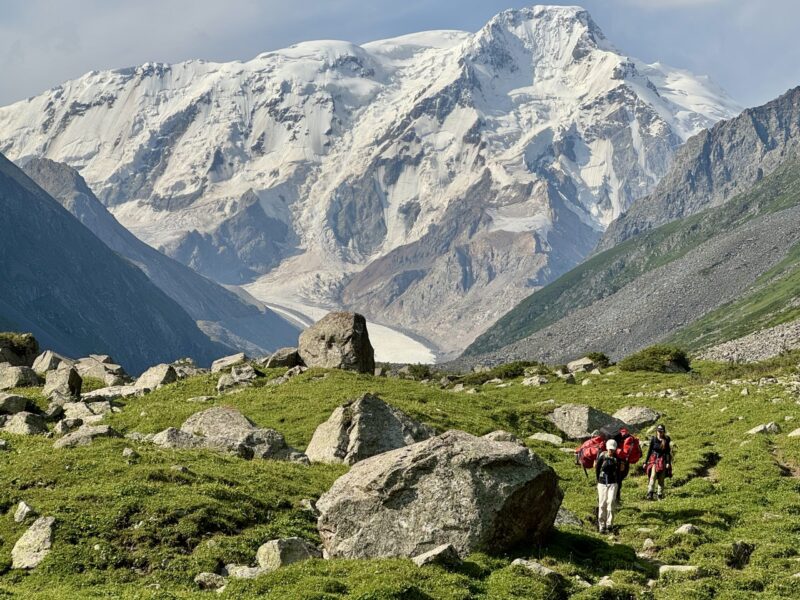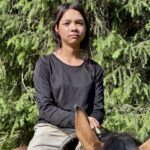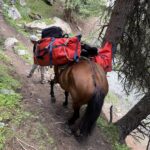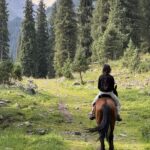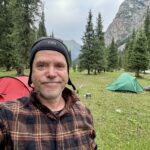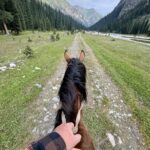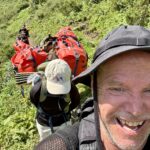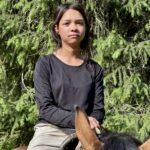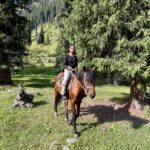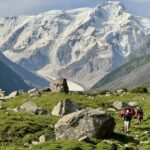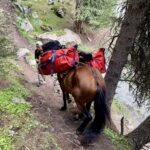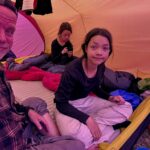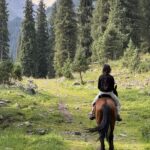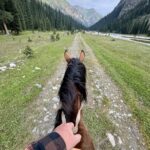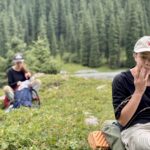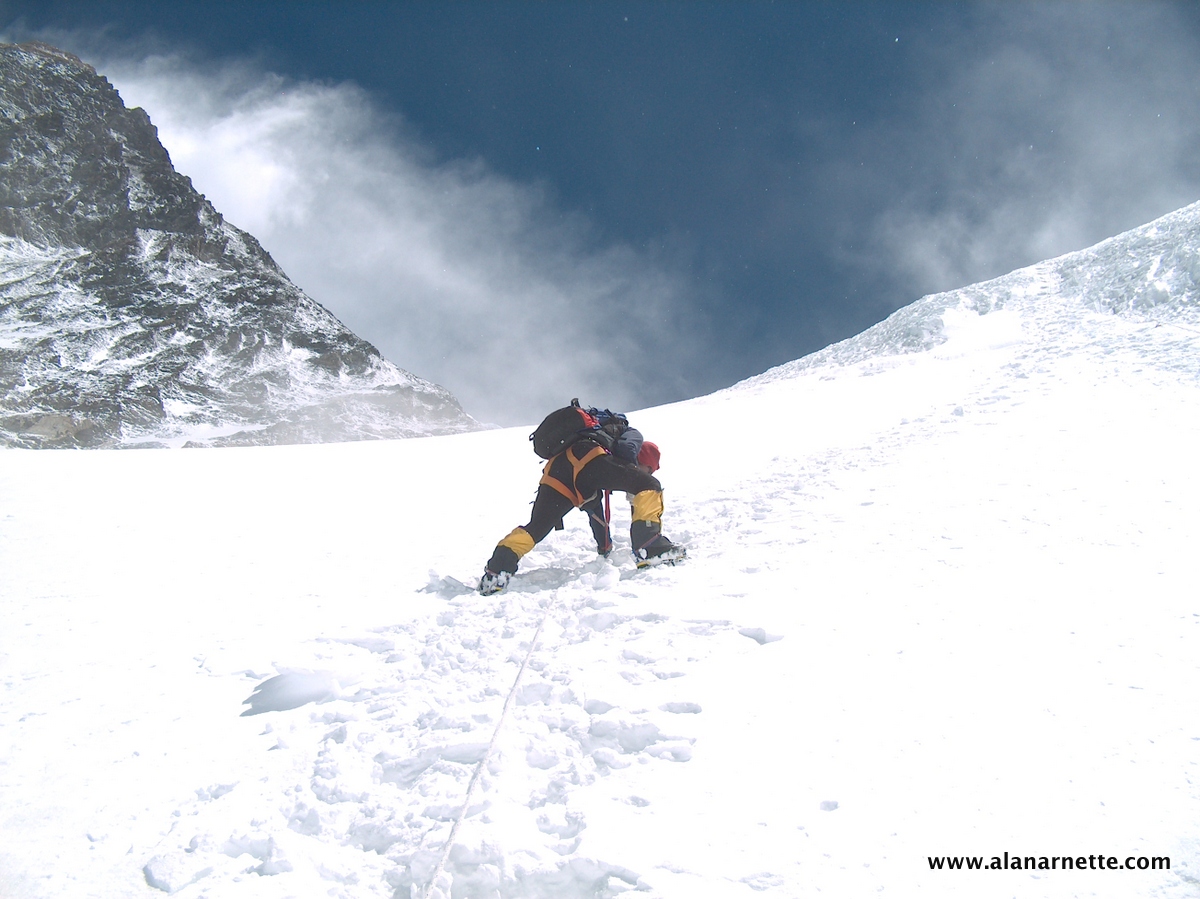Hardship and Joy in Kyrgyzstan’s Karakol Valley
A challenging four-day trek leads to a moment of pure parental happiness as Dana rides Toru solo.
Back at Camp: Exhaustion and Relief
I experienced one of the happiest moments in my life in the Karakol Valley of Kyrgyzstan two days ago.
We had just made it back to the camp, which meant all the hard work was over. The previous two days had been brutally hard, and I hadn’t been this tired since the day I reached the other side of the Greenland Icecap almost a year ago. After 30 days the ice stopped, but we had to carry all the gear in turns over a high moraine wall to the other side, where a helicopter would eventually pick up our equipment and trash. The tiredness I felt at that moment was extreme. Anders helped me carry then — I’ll never forget that.
A Moment of Pure Joy: Dana Takes the Reins
This time, I asked Dana to sit up on Toru, our horse, and ride back on the trail south to help Alina with her gear. Being a Director of Photography on a journey like this is as hard as it gets. Dana had slowly taken over handling the horse, even on the trickiest and steepest parts, and the job she had done, very few adults could do. But so far she hadn’t ridden the horse without me holding a safety rope.
Now she climbed into the saddle, took the far‑too‑short reins, kicked her heels firmly, and Toru responded. The joy I saw on her face is something every parent lives for. It is also a feeling of being connected to something larger than oneself.
What a moment in life!
The Emotional Roller Coaster of Adventure
From experience I know there’s a tendency for these moments to arise after some sort of hardship when all human emotions have been played out — worry, amazement, anger, panic, irritation, joy and exhaustion in one. This was such a trip. It was not the trip I wanted my daughters to experience, too hard and potentially dangerous. I feared it might end with a cry of, “I don’t want to do this anymore. Ever.” It never came, because the girls are kind of used to these challenges. Even though Dana at the end said it was harder than our desert cycling in Namibia and extreme climbing in the heat of Anatolia combined.
But the girls are older today. Dana is extremely fit from football, and Eva always seems to be in a state of acceptance. This is what her issues with her eyes have taught her, I believe — it is what it is. Move forward; it will eventually get better.
Setting Out: Toru and the Trail
We started our trip just beyond the park entrance to Karakol National Park. Toru the horse was transported there by his owner, who was an hour late in the heat and left us with a very thin and torn saddle blanket. It became apparent immediately that Toru was exhausted. Since our last trip he had been out with another bunch of tourists who had lost the normal saddle blanket. How that is possible, I do not know. But it put us into trouble. First of all, a tired horse obviously wants to rest and eat — and Toru is a stubborn teenager. Secondly, on the first uphill climb in the humid heat, the saddle rolled a bit. We had to take it off and redo it. We added an Arctic foam pad in the hope it would be enough. Time would tell.
We did 16 km the first day in strong heat and found a great campsite next to the beautiful Karakol River. The walk had been mainly on a road, and quite a few walkers and cyclists passed us, most heading for Ala Kul Lake. We haven’t seen too many tourists on this trip, and very few of them even said hello. The friendliest were the English. The least friendly were local tourists and Russians. They just passed us, no matter what the situation was. At one stage the gear had rolled because of the poor saddle, and I needed a centimetre of help to get the knot out. Maybe five tourists passed me; none stopped even though they saw my problem. One Russian just shouted, “No English.” I was ahead of the rest of the team most of the day.
The scenery was stunning!
The Hardest Day: Up and Over
The next day was the hardest. We didn’t manage to leave as early as I hoped to avoid the strong heat of midday. Our goal was to make it as far as we could, to get a great view of Pik Karakol and its glacier. If I had known then what the trail would look like, I wouldn’t have pursued it with a horse!
Back in 1997 I crossed the Andes with eight horses and three other people. It was a very hard ride, but we never stepped off the horses. This time, we just had Toru as a pack horse. We immediately realised he wasn’t used to carrying loads in forests. He ran into trees with the gear way too often, so Dana and I had to steer him past all the main trees. Every time he hit a tree, he panicked and tried to free himself of the gear. We were climbing a mountain wall high above the river, offering stunning and steep views.
The gear rolled the first time after just 20 steep, hot minutes in the steepest part. We unpacked and repacked. Since I had lumbago, I couldn’t lift the gear — it weighed around 35 kg. The three girls did the job; it was just a case of getting it on. This is when we added the foam pad. After this climb, it went steeply down to the river. At one stage, while I was leading Toru and he balked, he pushed too hard, took a small leap and landed on my back. My backpack saved me. The pack saddle had again rolled a bit and needed adjustment. I was extremely tired and hot. I screamed and yelled, as I do when I can’t handle my exhaustion. Dana just looked at me and said, “Calm down, Dad.”
We set off again up another steep forest trail that opened to dramatic views of steep mountain walls. It was the same story: extreme heat, the gear hitting trees, and Dana and me working hard to slow Toru down. I told Dana, “Be close to him, use your body to control his ups and downs, and don’t get stepped on or pushed.” The heat was burning. It was a hellish day. I am not impressed with my own behaviour, but it felt better when Dana said, “I understand you. We are doing our best, and if Toru doesn’t help, he could fall down the side of the mountain.”
This was a very educational journey up the steep trails. All focus was on just making everyone feel safe and getting up to the plateau, out of the forest. That happened after six hours. Toru relaxed a lot, at least for half an hour, until the viciously biting horseflies arrived and made his life hell — and ours. He just couldn’t deal with them. I knew they would go away once it got dark.
Lessons for Future Expeditions
One of the major reasons for this journey was to figure out what to do next year — whether to plan a big expedition on horseback, on foot, or even by bike. The girls want the horse and riding. But I am not ever going to bring a horse on a trip like this. Only reasonable trails. Because this is no fun at all for anyone.
That said, after we saw the superb view over Pik Karakol and returned the next day on the same trail, I realised how much everyone in the team had become closer, had learned a lot about themselves and life, and I saw how my daughters had developed in this short period of time.
Reflections on the Team
Eva takes life in a rational way. She prefers to be alone as much as possible, listening to music or just thinking, which a trip like this allows. But when her help is needed, she is always there to assist and make life easier for everyone — a huge skill. Every expedition needs an Eva for balance and perspective.
Dana has become her normal sociable self again, enjoying talking and the company of people. She is as gregarious as I remember her before her teen period started! She is a hardworking explorer who can do most jobs at 12 years of age, and always in a good mood.
Alina, the DOP (Director of Photography), couldn’t in her wildest dreams believe that this job would be this demanding! She is not only the DOP but also translator and fixer in one. Way too demanding — she is doing three people’s work. But she has done a great job, always there, always hardworking, and she feels very much a big part of this team. What a great addition. She is the new Jimmy Chin of Kyrgyzstan – referring to the renowned adventure photographer and climber.
Heading Back: Mud, Rain and Lessons Learned
We made it back — far easier than going up — and put up camp very early on the third day, at the same spot as the first day. The trip down was much easier thanks to Dana’s hard work and help, but the saddle rolled twice, and this did not ease my irritation with the horse owner. His main interest is making money by renting out his horse as much as possible. Toru is a lovely horse. We thought at first we would buy him for next year, but we believe he won’t be ready for such a trip.
We have also learned that we will come early, find the right horses, train them ourselves, and bring the best gear from back home — yet another lesson learned.
The 16 km back to the entrance was dominated by mud and heavy rain but done on a road. Many tourists were heading for Ala Kul Lake, and few said hello, though many took photos of Toru without asking — again, really odd behaviour.
A Trip to Remember
This is it for this time — many lessons learned, and I do rate this last trip as one of the most impactful and fantastic adventures, much because it was with my wonderful, exceptional daughters!
